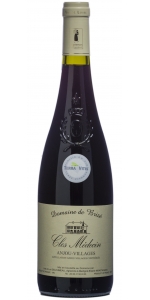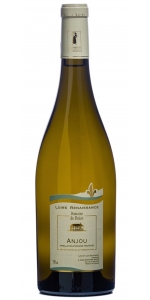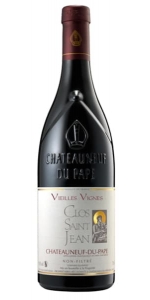Brize Clos Medecin Anjou Villages Rouge 2021
| Country: | France |
| Region: | Loire |
| Winery: | Domaine de Brize |
| Grape Type: | Cabernet Franc |
| Organic: | Yes |
| Vintage: | 2021 |
| Bottle Size: | 750 ml |
Brize Clos Medecin Anjou Villages Rouge is made from 60% Cabernet Franc and 40% Cabernet Sauvignon.
This is the flagship of the Estate. Clos Medecin has been produced at the estate for 90 years. All the grapes for this wine come from a very special parcel. The wine offers red fruit aromas. It is fresh, round and ample in the mouth.
Brize Loire Renaissance Anjou Blanc is made from 100% Chenin Blanc.
Anjou Blanc Renaissance was entirely fermented and aged in French oak barrels. The wine is dry and powerful with an intense bouquet of apricot, vanilla and honey.
Excellent when paired with lobster or white fish with a creamy sauce.
This wine is one of the absolute benchmarks for fine Priorat, and a reference in Spain. Sourced from 3 small vineyards in the Gratallops, this blend of Grenache and Syrah undergoes strict berry selection and is fermented and aged for 20 months in barrels and amphorae. It is all about dense fruit, exotic spice and licorella minerality, with a freshness and elegance are truly singular, even among the top wines of the appellation.
Review:
A complex bouquet that develops with a little time in the glass from fresh wild berry notes to floral and savoury-herbal nuances with violets and dried thyme. Extremely elegant on the palate, intense yet light-footed and vibrant, with fine-grained, perfect tannins and a long mineral, ethereal and savoury finish.
-Falstaff 100 Points
The 2021 Clos Erasmus is not a shy wine and comes in at 15% alcohol but with a pH of 3.3. The search here is for balance, as power comes as a given in Priorat. It was produced with 70% Garnacha and 30% Syrah, mostly from 40-year-old vines, except for a small plot of around 85-year-old vines. The vineyards are certified organic, and they've practiced biodynamics since 2004 but never got certification. The vinification is simple and the same as for Laurel: the bunches cooled down for 24 hours before being sorted and destemmed, then the grapes were put into the vat, where they warm up and start fermenting with the indigenous yeasts. It was pressed and put in barrels, 40% of them new, where it underwent malolactic and aged for 18 months. It feels like the most elegant and ethereal Erasmus ever despite the 15% alcohol on the label. It's very young and feels a bit shy, slightly developing notes of Mediterranean herbs, wild berries and flowers and is a little closed but very harmonious and insinuating. It's medium to full-bodied, with very fine and elegant but abundant tannins. It does feel lighter than previous vintages, possibly the effect of the cooler year. 3,400 bottles produced. It was bottled in May 2023.
-Robert Parker 99 Points
Bertrand Bachelet Maranges Rouge 1er Cru Les Clos Roussots is made from 100 percent Pinot Noir.
The Maranges appellation is the youngest of the Côte de Beaune family, making its debut in May 1989. It spans three villages: Dezize-lès-Maranges, Cheilly-les-Maranges and Sampigny-les-Maranges. Several hills and slopes make up the appellation; they face south/south-east, at an altitude of between 200 and 400 meters. This appellation produces mainly red wines comprising 95% of total production.
The Maranges 1ers Crus are spread over seven distinct terroirs: "Les Clos Roussots", which represents the second largest terroir of the appellation, spans the Cheilly-les-Maranges and Sampigny-les-Maranges areas.
The wine boasts a beautiful bright red color. The nose provides subtle harmony between red and black fruits, spices and vanilla. On the palate, this wine is both solid and fresh, harmonious and bold.
Enjoy with a veal roast and sweet potatoes or matured cheeses.
Bertrand Bachelet Maranges Rouge 1er Cru Les Clos Roussots is made from 100 percent Pinot Noir.
The Maranges appellation is the youngest of the Côte de Beaune family, making its debut in May 1989. It spans three villages: Dezize-lès-Maranges, Cheilly-les-Maranges and Sampigny-les-Maranges. Several hills and slopes make up the appellation; they face south/south-east, at an altitude of between 200 and 400 meters. This appellation produces mainly red wines comprising 95% of total production.
The Maranges 1ers Crus are spread over seven distinct terroirs: "Les Clos Roussots", which represents the second largest terroir of the appellation, spans the Cheilly-les-Maranges and Sampigny-les-Maranges areas.
The wine boasts a beautiful bright red color. The nose provides subtle harmony between red and black fruits, spices and vanilla. On the palate, this wine is both solid and fresh, harmonious and bold.
Enjoy with a veal roast and sweet potatoes or matured cheeses.
Clos Saint-Jean Chateauneuf Du Pape Vieilles Vignes is made from a Grenache, Syrah, Mourvedre, Cinsault, Vaccarèse and Muscardin, the Châteauneuf-du-Pape Vieilles Vignes is made from old vines located in and around Le Crau. The Grenache is aged in concrete for 12 months while the remainder is aged in demi-muid.
Review:
This has good concentration and energy to the dense core of dark fruit and bitter cherry, with great poise and elegance despite its ripeness (an impressive feat for the vintage). Guided by finely crushed mineral accents and tannins, this reveals pretty high-toned floral notes and leafy tobacco. Grenache, Syrah, Mourvedre, Cinsault, Vaccarese and Muscardin. Drink now through 2032. 900 cases made.
-Wine Spectator 95 Points
Brize Clos Medecin Anjou Villages Rouge is made from 60% Cabernet Franc and 40% Cabernet Sauvignon.
This is the flagship of the Estate. Clos Medecin has been produced at the estate for 90 years. All the grapes for this wine come from a very special parcel. The wine offers red fruit aromas. It is fresh, round and ample in the mouth.
Domaine de Brize is located in the town of Terranjou, in the Maine-et-Loire department of the Loire Valley. The 40 hectare-estate was born in the middle of the 18th century, founded by the Delhumeau family. The winery strived between the two world wars under the leadership of Pierre, a young, innovative, ingenious and combative man who compensated the loss of his mutilated hand during the War. He transmitted his passion for wine to his grandson Marc who followed in his footsteps and ran the property for 30 years, with the assistance of his two brothers. His son Luc joined the family estate in 1989, then his daughter Line came on board in 1992 together with her husband Didier. Brother and sister Luc and Line represent the 5th generation of the family winemakers and the 9th generation in the farm.
The vineyard is planted on highly diversified soils dominated by silico-clay, shale-sandstone and faluns. The viticulture practices meet the 'Terra Vitis' approach in respecting nature, people, the environment and the soil.
- back
The Grade Napa Cabernet Sauvignon Winfield Vineyard is made from Napa Valley Cabernet Sauvignon.
“This wine expresses a focused balancing act of dark, rich black fruit, and a fine tannin structure, illuminated through the core with a laser-like acidity. The wine displays a deep purple-red hue with a cranberry halo. Aromas of cassis, cinnamon, citrus oil, roasted meat, and lilac swell from the glass.
“The palate is marked by a wave of jet-black brambly fruit up front, followed by an exotic spice mid-palate and a long, complex finish that lasts and lasts expressing notes of flowering jasmine, and oolong tea. The silky tannins hold everything together and will certainly allow this wine to evolve in the cellar for at least 7-10 years.” - Thomas River Brown
Review:
The 2019 Cabernet Sauvignon Winfield Vineyard is a blend taken from three blocks in the vineyard. A potent, layered Cabernet, the Winfield is super-expressive today. Dark red cherry, licorice, incense and savory herbs all flesh out in a potent, resonant Calistoga Cabernet that hits all the right notes. This is impressive, to say the least.
-- Antonio Galloni 95 Points
Oumsiyat Assyrtico is made from 100 percent Assyrtico.
Subtle aromas of white fruits and flinty mineral notes are framed by a delicate floral character. Linear on the palate with a wonderfully refreshing and mouthwatering finish.
RS: 2g/L
The grapes were carefully selected to ensure the healthy and ripe fruit was vinified and then gently pressed. The must was racked and cool fermented in stainless steel tanks at controlled temperatures of 14 to 16°C, with selected yeasts. The wine delivers a crisp, fresh style as it did not go through malolactic fermentation. It was lightly filtered prior to bottling.










